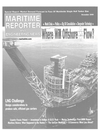
PRS Seeks Strong Comeback, Stresses Safety
A large number of high profile tragedies over the last decade — despite the marine industry's overall good record for the safe transport of materials and people — have resulted in the loss of many lives and ships. Even in the face of increasing technology and training, the industry is oftentimes humbled by the power of the sea.
The reasons these tragedies happen are diverse, from human error to equipment faltering. However, another type that is equally insidious is structural failure, which has been identified as a significant reason for the loss of some types of ship, particularly older bulk carriers and tankers.
To minimize deterioration of a ship's structure throughout its whole lifetime, information on the ship's condition - as variously noted by class, ship owner, crew, administration, PSC, insurers, etc.
— needs to be recorded and accumulated in a single, ship-based logbook.
The concept of this new, integrated method of tracking a ship's condition — which PRS has dubbed Consolidated Supervision System (CSS) — will create the basis for a single-source, centrally maintained record of relevant information.
Under the proposed system each vessel will carry a CSS Record Book to be issued by and registered with PRS.
Observations relating to the hull structure and equipment condition, as made by the ship's crew and all other parties working on or inspecting the vessel, will be entered in the CSS Record Book to provide a single, central reference point for the accumulated information.
The system foresees that minor repairs may be considered as an element of the on-going maintenance process, provided that such repairs are carried out by appropriately qualified crew members and in accordance with approved procedures.
PRS proposes to develop and introduce a new tool to meet the needs of CSS. Provisionally called "frame technology" (FT), this will be planned individually for each ship applying and approved for CSS entry, and will be delivered approximately one year after the date of introducing the system. The FT instrument will contain information on particulars concerning design, structural areas requiring special attention, guidelines for inspections, permissible corrosion diminution of structural elements, as well as PRS accepted repair technology (diagrams, materials, welding sequence, etc.) to be applied by the crew. Crew training will be provided as an integral part of the FT-system implementation, with "hands on" training undertaken on board the ship by PRS surveyor-instructors. It will cover the Owner Officers-supervisors (e.g. Chief Engineer, Chief Mate, etc.) appointed by the Owner, as well as the crew members (fitters) who may obtain authorization to perform specified repairs (as prescribed and detailed in a ship's FT).
Circle 79 on Reader Service Card
Other stories from November 2000 issue
Content
- Cornering the ULCC Niche page: 8
- The Future Of E-Commerce: Will The Maritime Industry Be Left Behind? page: 12
- Shipowners, Charterers Launch New Internet-Based Shipping Exchange page: 15
- Shipbuilders Complain To EU About S. Korean Subsidies page: 16
- Robert Allan Lands Fireboat Design Contract page: 16
- Tribon Solutions Signs Contract With DHI page: 18
- FBMA Babcock Secures TriCat Order page: 19
- Keppel Shipyard Is Awarded Jumboization Contract page: 19
- World Single Hull Tanker Phase-Out Is Coming page: 22
- INTERTANKO Calls For "Reasoned Solution" In Wake Of Single Hull Phase Out page: 23
- Exxon Mobil Appeal Rejected page: 24
- IMO Forum To Address High-Density Oil Spills page: 24
- Greek Ferry Disaster Will Result In Safety Enhancements page: 26
- New Safety Technology Unveiled page: 26
- Oil Instability, consolidation Muddy Offshore E&P Picture page: 27
- World Floater Market Is Stable page: 29
- Olympic Engine Selection Evokes Thoughts Of "Green" page: 31
- Volvo Penta Offers Larger Engine Range page: 33
- MTU Presents New 8000 Series page: 34
- ZF Fortifies Product Line, Business Plan page: 36
- ABS Innovates For Petrobras Project page: 40
- Environmentally Sound, Commercial Efficient Wastewater Treatment page: 45
- Ansell Jones Uniquely Serves Offshore Market page: 48
- Deepwater Business Prospects Ripe page: 49
- W&D Completes Moran Series page: 50
- Atlantic Marine Awarded Additional ATB Contract page: 50
- Klyne Tugs Orders AHTS From China page: 52
- What Happened to the Hunley: ? page: 58
- Companies Bond Together To Form American Salvage Association page: 64
- Gas Ship Design Challenges page: 66
- McAlear Named CEO Of Kvaerner Philadelphia Shipyard page: 73
- Historical Keel Laying Occurs At Ingalls page: 74
- Polish Shipbuilding Industry Consolidates, While Competition Continues To Boom page: 75
- PRS Seeks Strong Comeback, Stresses Safety page: 80
- New Marine Technology: The Hallmark of SMM 2000 page: 81
- The "Wired" Ship page: 88
- Flat Screens, Big Images page: 88
- Wartsila Unveils Plans For The Future page: 89
- Wartsila To Provide Power On Unique Icebreaking Tankers page: 90
- Kvaerner Delivers Explorer of the Seas page: 94
- The SatCom Shakeout page: 95

